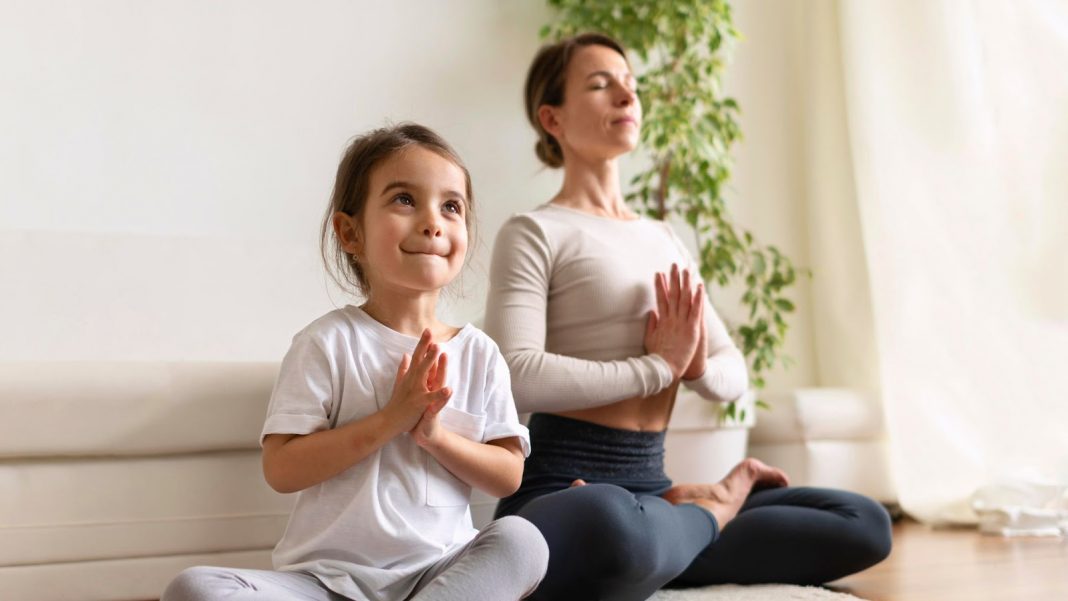Jaya Sati Bhagavati, a famous philosopher once said “Quiet the mind, and the soul will speak”. Perfectly capturing the essence of meditation for kids, this quote speaks volumes. Meditation is a practice that can foster calmness, focus, and emotional well-being in people of all ages. When you introduce your child to the practice of meditation, you not only help them increase their focus but also provide them with valuable life skills that can impact their overall development massively.
SplashLearn: Most Comprehensive Learning Program for PreK-5

SplashLearn inspires lifelong curiosity with its game-based PreK-5 learning program loved by over 40 million children. With over 4,000 fun games and activities, it’s the perfect balance of learning and play for your little one.
Try for freeThis blog will talk about what meditation is, how it can help kids and tips on how to help your kids start with this powerful exercise. We’ll also explore the latest research on the positive effects of meditation in children.
What Is Meditation?
Meditation is a practice of mindfulness and self-awareness, and this holds true for meditation for kids as well. The practice involves training the mind to observe thoughts without judgment. Meditation can help in relaxing the mind and is quite important in today’s world which is full of information overload. Meditation allows us to disconnect from external distractions and racing thoughts, enabling us to be present at the moment.
Meditation for kids is not about expecting them to sit still for long periods or attain a certain level of mastery. Instead, meditation must be a practice that lets them explore their thoughts and emotions and create a sense of peace. Regular practice of meditation helps children develop mindfulness, concentration, and emotional resilience. It encourages them to take time to breathe, relax, and simply be with their thoughts.
Related Reading: Strategies to Bring Out Mindfulness for Kids
Basics Of Meditation For Kids
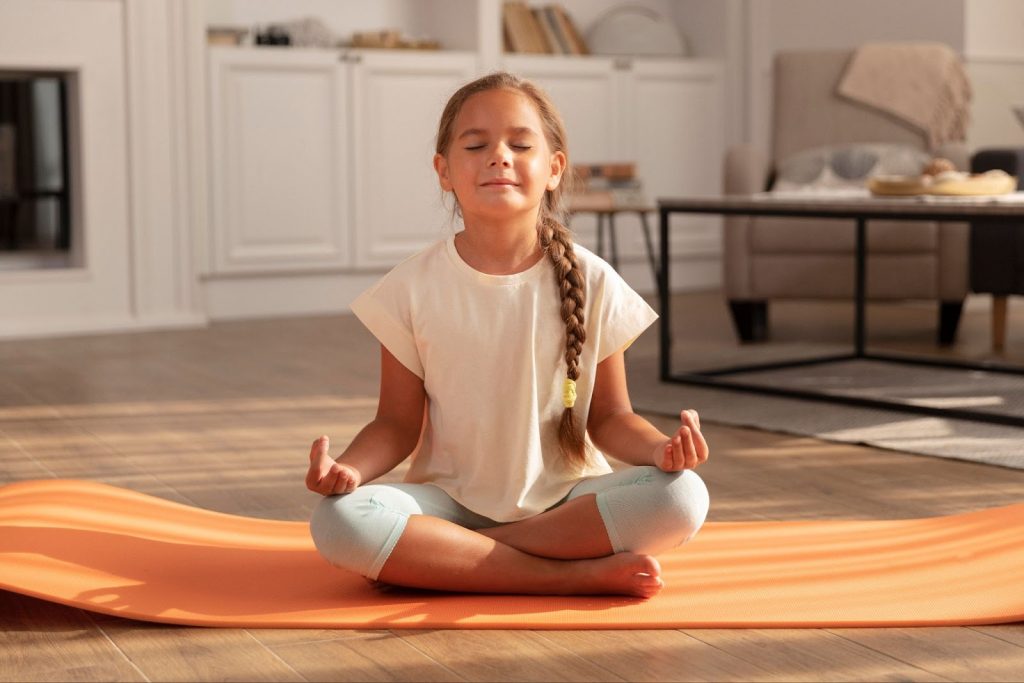
To perfect the practice, there are a few steps you need to ensure of before jumping in. Here is how you can help your kids meditate right:
1. Comfort and Preparation
You may want to begin the meditation session by incorporating some physical activities to help your child release excess energy and prepare for a calm and focused state. Consider a 30-second dance party, stretching, or jogging on the spot. These activities can help your child get the wiggles out and transition into a more peaceful mindset.
Once you and your child are ready, find a comfortable position for meditation. At this point, allow your kid to sit as they like- this might or might not be the cross-legged position or the classic “lay on your back” position. The ultimate goal is to ensure that they are feeling relaxed and at ease.
2. Focus with Breathing
To begin the meditation practice, focusing on the sensations in our bodies is a wonderful way to cultivate mindfulness and introduce meditation, especially for younger children who may have difficulty concentrating for long periods.
Start by guiding your child to focus on their breath. Now, guide them to place one hand on their belly and one on the chest and observe their how their chest and belly rise when they inhale and fall when they exhale. To create a rhythmic breathing pattern, you can count out loud. For example, you can guide them to inhale for a count of four, hold their breath for two counts, and exhale for a count of six.
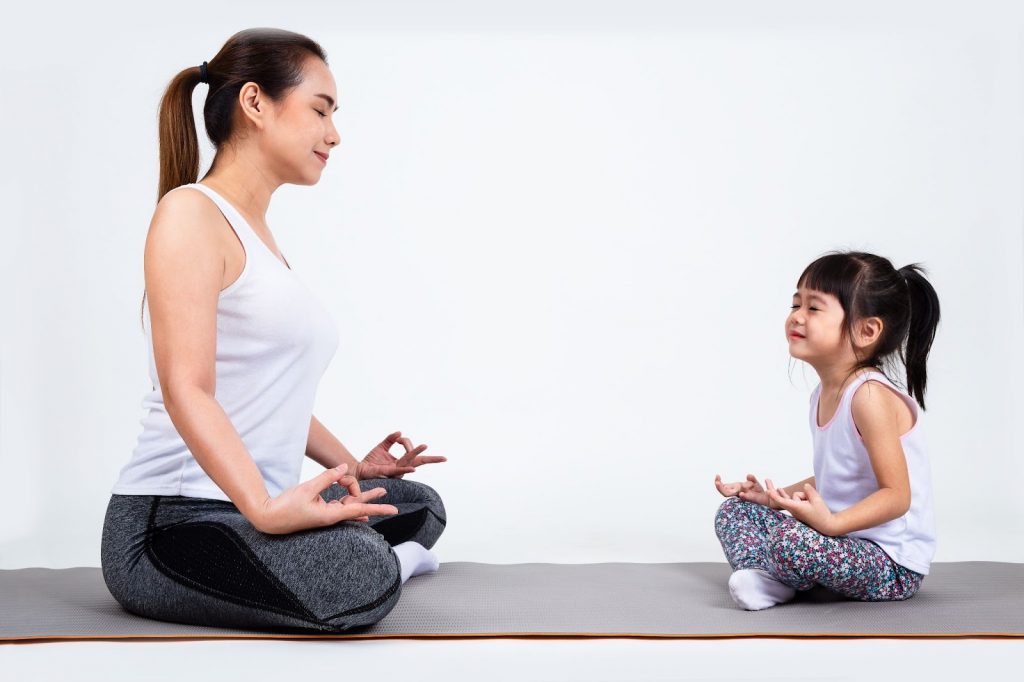
3. Story and Visualization
As your child becomes familiar with slow, mindful breathing, you can incorporate storytelling into your meditation practice. This technique is particularly effective during bedtime routines to help your child relax before sleep. Once your child is cozily settled in bed, guide them to close their eyes and focus on their breathing.
Begin telling them a story that allows them to focus on how their body is feeling, directing their awareness to the sensations they experience. Incorporate their favorite toys, people, or places into the story, encouraging them to use their imagination and visualize the narrative.
4. Body Scanning and Relaxation
To help your child connect with their body and promote overall relaxation, you can introduce body scanning and progressive muscle relaxation.
To do this, guide them to lie down as they feel comfortable. We’d suggest you do the same and lie alongside them so that they feel at ease. Begin from the top of the head and guide your child to notice any tightness or tension in their scalp. Encourage them to imagine the tightness melting away, just like ice cream melting, until their head feels completely relaxed. Continue progressively down the body, muscle by muscle, focusing on the nose, mouth, neck, and shoulders. Guide your child to relax each muscle as you progress, creating a sense of calmness throughout their entire body.
Who Can Benefit From Meditation?
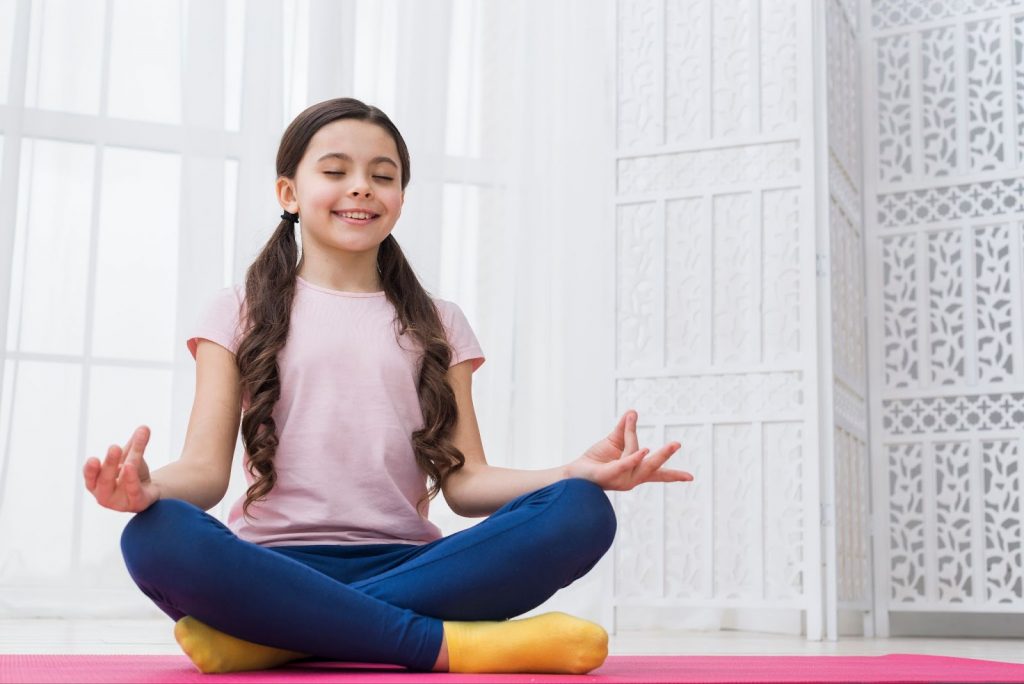
Meditation has been proven to reduce stress and anxiety in not just adults but also children. Anyone can learn and reap the benfits of this wonderful practice irrespective of age, gender, or race.
In children, even kids as young as two years old can start meditation and benefit from it. You can help them start with a simple guided meditation exercise and you’ll slowly see them being able to handle their emotions better, be more relaxed and communicate better with you.
Benefits Of Meditation For Kids
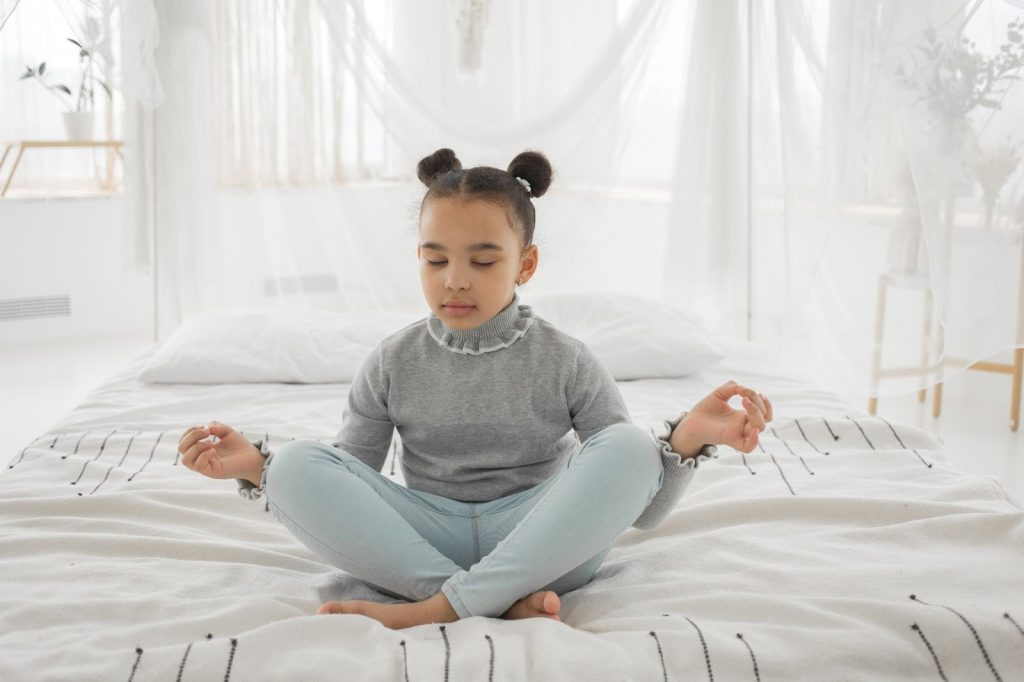
Guided meditation for children has a ton of amazing benefits- from enriching their well-being to nurturing their growth. Let’s explore some of the benefits of meditation for children.
1. Enhanced Learning Abilities
A study published in NCBI revealed that mindfulness meditation practices in school plays a huge role in improving kids’ emotional cognitive and social abilities. Different types of guided meditation can really help to improve academic performance in kids and can help them learn more effectively.
2. Reduced Stress Levels
Many studies indicate that meditation and similar mindfulness practices can help to reduce stress not just in adults but also kids. Study has revealed that kids who practiced mediation and other mindfulness exercises in school had reduced stress levels than the ones that didn’t.
Related Reading: Calming Strategies for Kids Every Parent Should Know
3. Strengthened Immune System
Children’s immune system is greatly affected by high levels of cortisol which is released during elongated periods of stress. As meditation reduces stress levels, it also helps to maintain a strong immune system in kids.
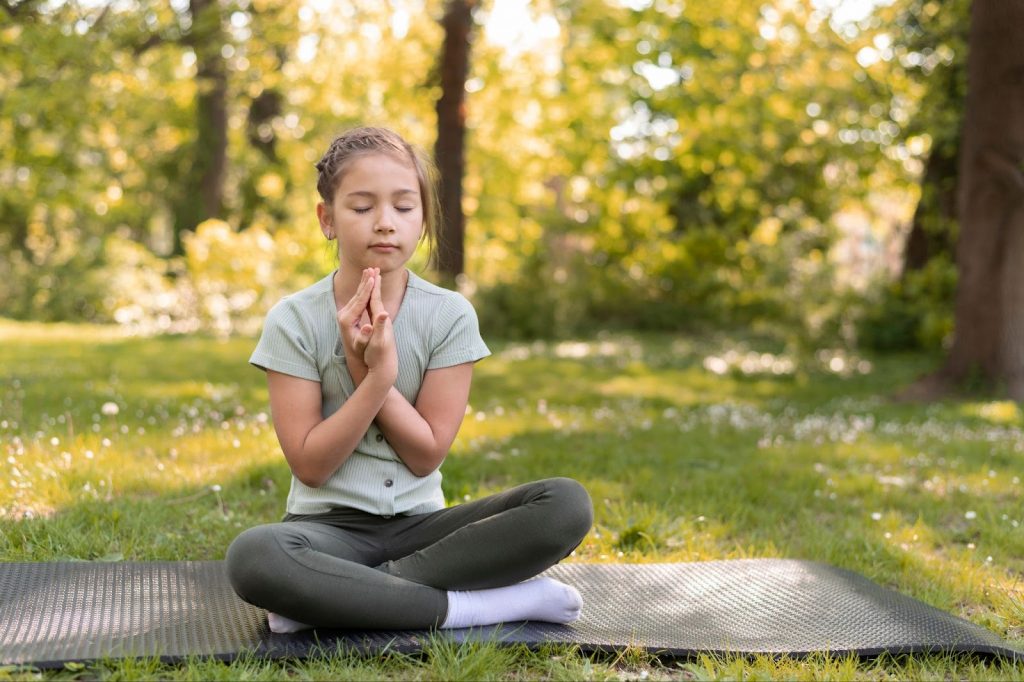
4. Improved Self-Regulation Skills
Meditation for children helps them to face the cahllenges in life with resilience and confidence. It helps them recognize their emotions and thoughts, acknowledge, and regulate them instead of reacting impulsively.
5. Improved Sleep Quality
A clinical trial study published on Pubmed reveals that mindfulness practices like meditation combined with other activities has the potential to improve sleep for adoloscent girls. Meditating prior to bedtime can improve kids’ quality of sleep and can help them fall asleep more easily too.
6. Enhanced Focus and Concentration
Benefits of meditation for students also include increased focus. Stress and anxiety hinders clear thinking and reduces affects kids’ ability to focus on a task. Since meditation works on reducing stress levels in kids, it also further helps them to focus on the task at hand better.
Related Reading: Best Concentration Games for Kids to Develop Super Focus & Attention Skills
Expert Tips For Child Meditation
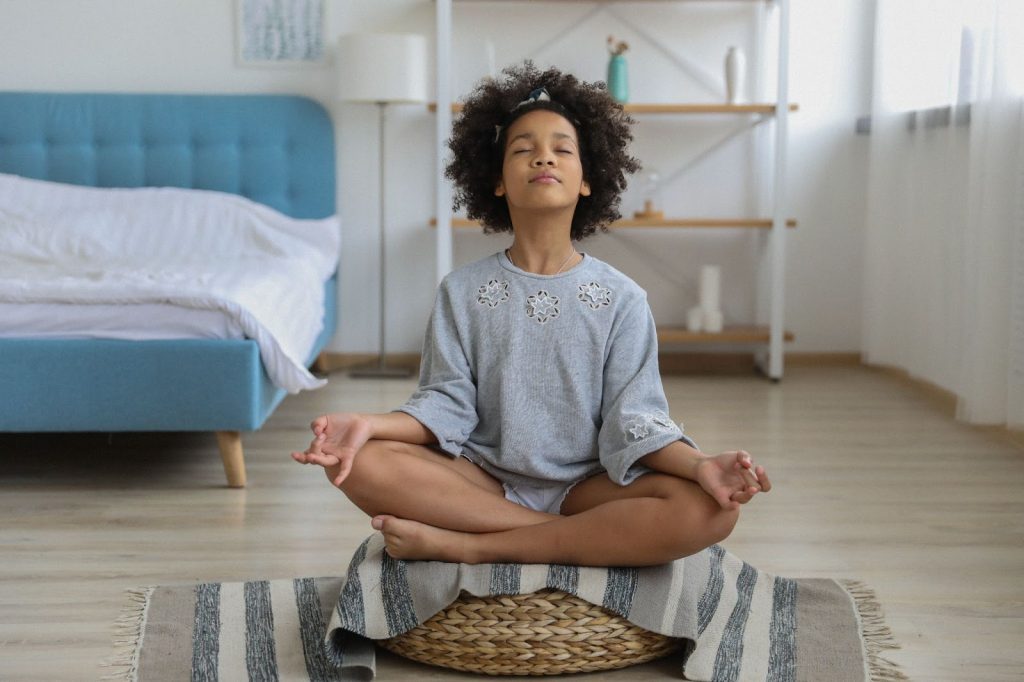
Meditation requires a lot of focus and stillness which can be hard for a lot of kids considering the fact that they love playing and running around. A few simple tips can really help them start meditating effectively.
- Start Small
Don’t force your kids to start with long durations of meditation. Start with short durations and as your kid slowly gets used to it, increase the time duration.
- Consistency is Key
Make sure you’re keeping a consistent time of the day and a specific place in the house aside for practicing meditation. You can also encourage them to change into comfortable clothing before starting the practice.
- Don’t Push
Lastly, remember that meditation is supposed to relax your kids. Remember that sometimes it can be difficult even for adults to stay still and focus on one task at a time. Kids can take longer to really get into the practice. Don’t force them into it and let them find their way towards it. With consistency and practice, they will surely be able to perfect it one day.
Meditation Techniques By Age
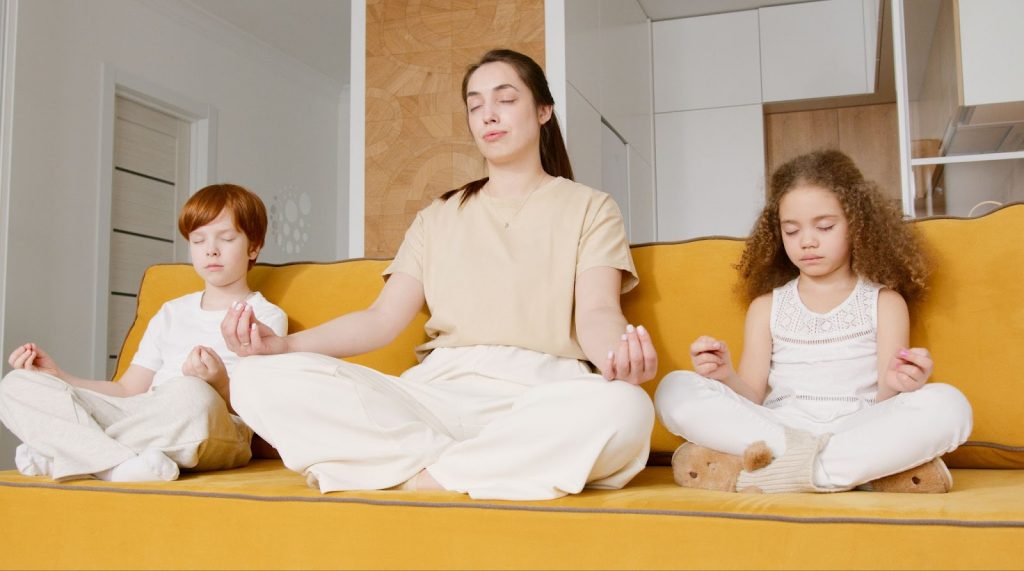
Tailoring meditation practices to your child’s age is crucial when introducing them to mindfulness. Recognizing their developmental stage allows for realistic expectations and a more effective journey of teaching kids to meditate. Here’s a closer look at age-appropriate approaches to meditation and mindfulness for children:
1. Toddlers (1-3 Years Old)
For toddlers, meditation centers around mindful movement. Begin by discussing things that bring them joy, like butterflies, superheroes, or favorite treats. Then, address any sources of unhappiness and ask them to identify where they feel it in their bodies. To alleviate negative feelings, guide them to take slow, deep breaths. This simple technique helps their brains recognize stress signals and respond appropriately, fostering self-care skills even in your absence.
2. Preschoolers (3-5 Years Old)
Preschoolers can benefit from incorporating storytelling into meditation. Start by having them lie down in a relaxed position. Then, narrate a gentle story that prompts them to focus on how each body part feels. If you’re looking for some great ways of meditation for preschoolers, this storytelling approach is great as it engages their imagination and helps them cultivate body awareness.
3. Kindergarteners and Older (5 Years +)
For school-aged children, making meditation inviting is key. Music can be highly effective in creating a serene atmosphere. While traditional Tibetan singing bowls are ideal, nature sounds can also bring about a sense of calm. Playing soothing music during meditation sessions helps restore balance and allows children to connect with their inner selves.
Related Reading: Best Meditation Videos for Kids
Research on the Benefits of Meditation in Children
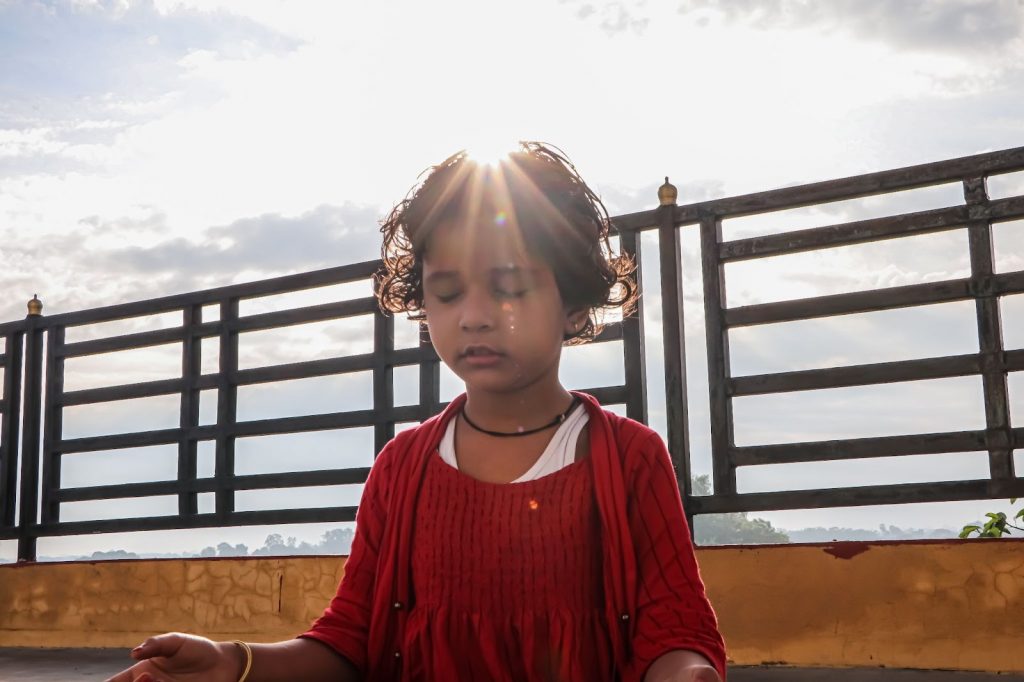
Research on the benefits of meditation in children has provided valuable insights into the positive impact of mindfulness practices on their well-being. Numerous studies have demonstrated the importance of meditation for kids in various aspects of their development.
- One study conducted by Sciutto et al. investigated the effects of a school-based mindfulness program on young children. The results showed that participation in the program led to improvements in attention, social skills, and overall psychological well-being.
- Another study by Zoogman et al. focused on the impact of mindfulness meditation on reducing symptoms of anxiety and depression in adolescents. The findings revealed that regular meditation practice significantly decreased anxiety and depression levels among the participants. These studies highlight the potential of meditation to enhance children’s cognitive abilities, emotional well-being, and mental health.
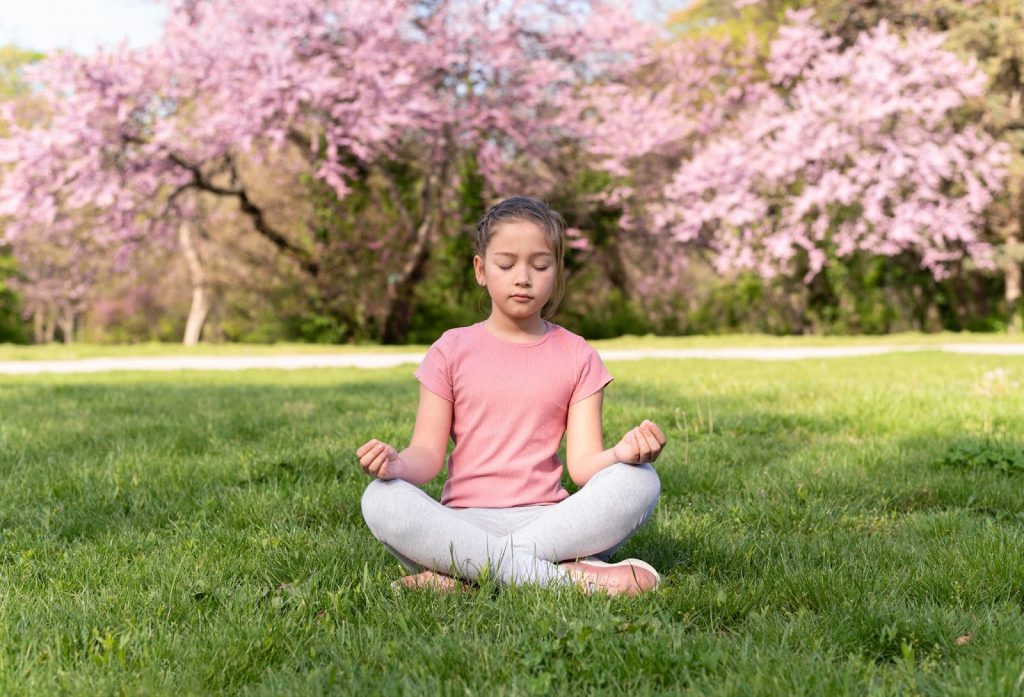
- Additionally, research has shown that meditation can positively influence kids’ academic performance. A study by Schonert-Reichl and Lawlor (2010) explored the effects of a mindfulness-based social-emotional learning program in schools. The results indicated that students who participated in the program demonstrated significant improvements in attention, self-regulation, and academic performance compared to their peers who did not engage in mindfulness practices.
- Furthermore, a meta-analysis conducted by Zenner et al. (2014) examined the overall effects of meditation on children and adolescents. The analysis revealed that meditation interventions had a moderate effect size in improving attention, executive functioning, and overall psychological well-being. The findings from this meta-analysis further support the notion that meditation holds significant benefits for children’s cognitive and emotional development.
Conclusion
Meditation has the ability to transform kids’ lives and help them face the challenges of life head on. From enhanced focus to better sleep, meditation has a lot of benefits for kids. As Dr. Dan Siegel, a renowned psychiatrist and mindfulness expert, aptly stated, “Meditation is not about stopping thoughts, but recognizing that we are not our thoughts; we can choose to let them go.” Remember, when you teach your kids this powerful practice, you give them the gift of resilience and mindfulness. And that’s why, it is also important to be patient and gentle with them during this process.
Frequently Asked Questions (FAQs)
How long should a meditation session be for kids?
The duration of a meditation session for kids can vary depending on their age and level of comfort. It’s best to start with shorter sessions, such as a few minutes, and gradually increase the duration as they become more accustomed to it.
How can parents and educators support children in practicing meditation?
You can support children in practicing meditation by setting a regular routine, providing a quiet and comfortable space, and being positive role models by practicing meditation themselves.
How long will it take to see the benefits?
When it comes to observing the benefits, don’t expect immediate fireworks or dramatic changes. Instead, the transformations may manifest in more subtle ways. Rather than fixating on the outcomes, it’s crucial to trust in the process itself.

















